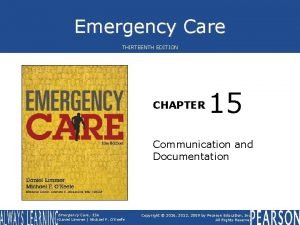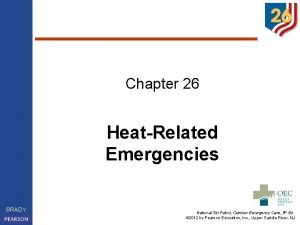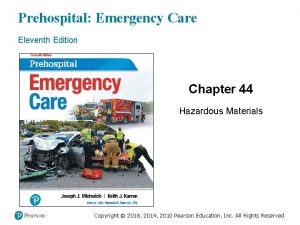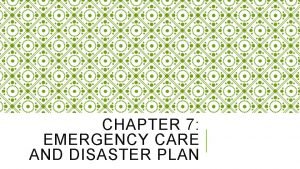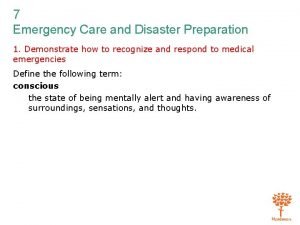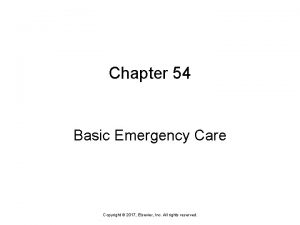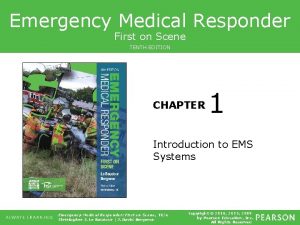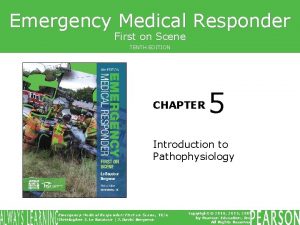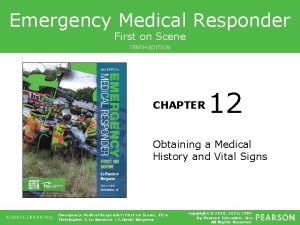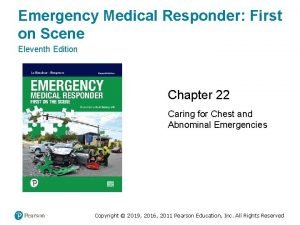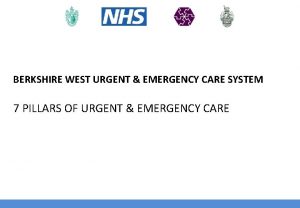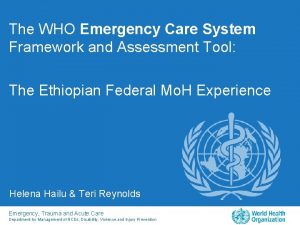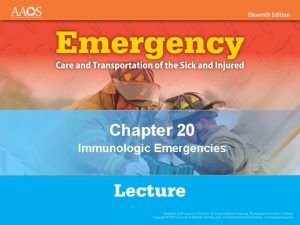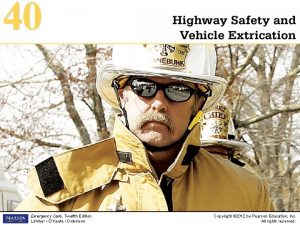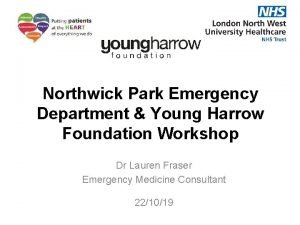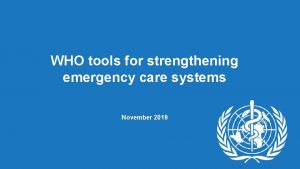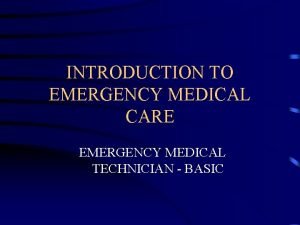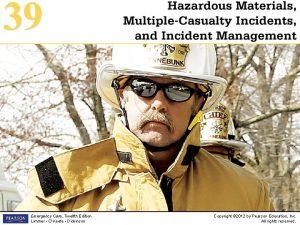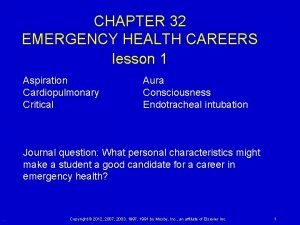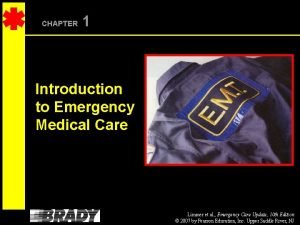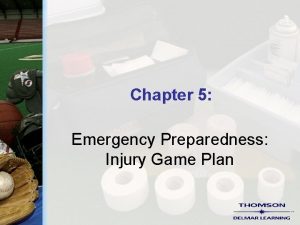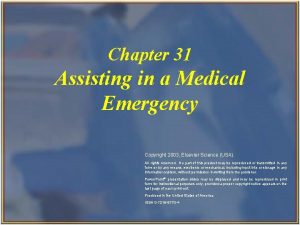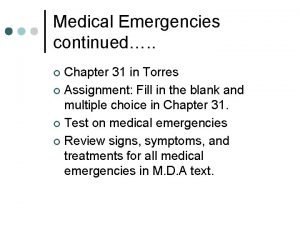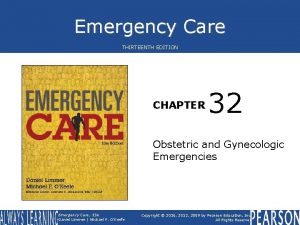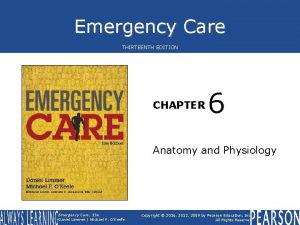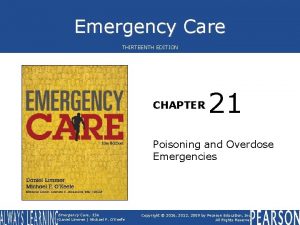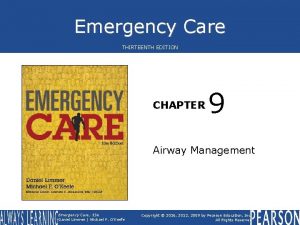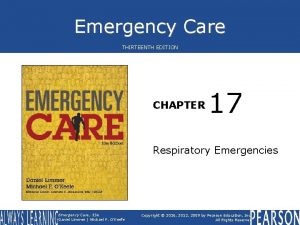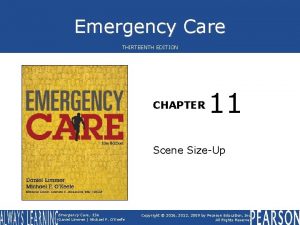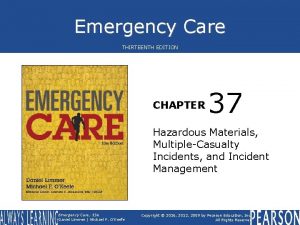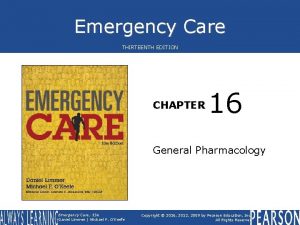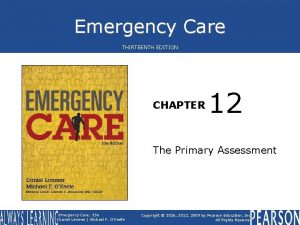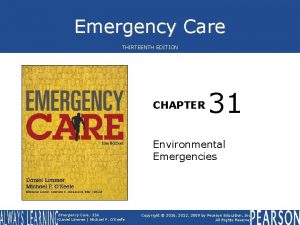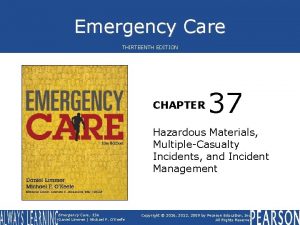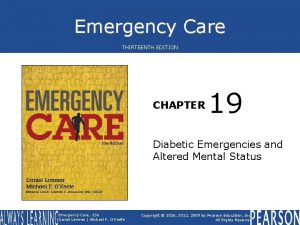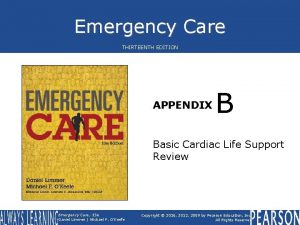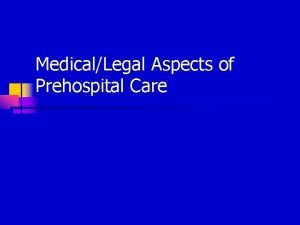Emergency Care THIRTEENTH EDITION CHAPTER 4 MedicalLegal and




















































- Slides: 52

Emergency Care THIRTEENTH EDITION CHAPTER 4 Medical/Legal and Ethical Issues Emergency Care, 13 e Daniel Limmer | Michael F. O'Keefe Copyright © 2016, 2012, 2009 by Pearson Education, Inc. All Rights Reserved

Multimedia Directory Slide 7 Legal Issues in Healthcare Video Emergency Care, 13 e Daniel Limmer | Michael F. O'Keefe Copyright © 2016, 2012, 2009 by Pearson Education, Inc. All Rights Reserved

Topics • Scope of Practice • Patient Consent and Refusal • Other Legal Issues Emergency Care, 13 e Daniel Limmer | Michael F. O'Keefe Copyright © 2016, 2012, 2009 by Pearson Education, Inc. All Rights Reserved

Scope of Practice Emergency Care, 13 e Daniel Limmer | Michael F. O'Keefe Copyright © 2016, 2012, 2009 by Pearson Education, Inc. All Rights Reserved

Scope of Practice • Regulations and ethical considerations that defines the scope, or extent and limits of an EMT's job • May include skills and procedures • Determined by national, state, local laws, statutes, and protocols Emergency Care, 13 e Daniel Limmer | Michael F. O'Keefe Copyright © 2016, 2012, 2009 by Pearson Education, Inc. All Rights Reserved

Standard of Care • Care that would be expected from an EMT with similar training when caring for a patient in a similar situation • Meeting standard of care reduces risk of legal action • Scope of practice § What you can do • Standard of care § How you should do it Emergency Care, 13 e Daniel Limmer | Michael F. O'Keefe Copyright © 2016, 2012, 2009 by Pearson Education, Inc. All Rights Reserved

Legal Issues in Health Care Video Click on the screenshot to view a video on the topic of legal issues in health care. Back to Directory Emergency Care, 13 e Daniel Limmer | Michael F. O'Keefe Copyright © 2016, 2012, 2009 by Pearson Education, Inc. All Rights Reserved

Patient Consent and Refusal Emergency Care, 13 e Daniel Limmer | Michael F. O'Keefe Copyright © 2016, 2012, 2009 by Pearson Education, Inc. All Rights Reserved

Consent • Permission from patient to assess, treat, and transport • Expressed consent § Must be informed • Implied consent § Assumed consent § Follow local laws and protocols. continued on next slide Emergency Care, 13 e Daniel Limmer | Michael F. O'Keefe Copyright © 2016, 2012, 2009 by Pearson Education, Inc. All Rights Reserved

Consent • Children and mentally incompetent adults § Minors not legally permitted to provide consent or refusal for treatment § Obtain from parent or legal guardian § Possible exceptions (check local law) • In loco parentis • Emancipated minors continued on next slide Emergency Care, 13 e Daniel Limmer | Michael F. O'Keefe Copyright © 2016, 2012, 2009 by Pearson Education, Inc. All Rights Reserved

Consent • Children and mentally incompetent adults § Possible exceptions (check local law) • Life-threatening illness or injury • Minors who have children • Minors serving in armed forces continued on next slide Emergency Care, 13 e Daniel Limmer | Michael F. O'Keefe Copyright © 2016, 2012, 2009 by Pearson Education, Inc. All Rights Reserved

Consent • Children and mentally incompetent adults § Adult patients incapable of informed decisions about care • State and local laws and protocols permit transport of such patients under implied consent continued on next slide Emergency Care, 13 e Daniel Limmer | Michael F. O'Keefe Copyright © 2016, 2012, 2009 by Pearson Education, Inc. All Rights Reserved

Consent • Involuntary transportation § Patient considered threat to himself or others § Court order § Usually requires decision by mental health professional or police officer § If patient restrained, must not risk legal liability Emergency Care, 13 e Daniel Limmer | Michael F. O'Keefe Copyright © 2016, 2012, 2009 by Pearson Education, Inc. All Rights Reserved

When a Patient Refuses Care • Patient may refuse care or transport under the following circumstances: § § Patient form. must be legally able to consent. must be awake and oriented. must be fully informed. will be asked to sign a "release" • Despite all precautions, EMT may still be held liable. continued on next slide Emergency Care, 13 e Daniel Limmer | Michael F. O'Keefe Copyright © 2016, 2012, 2009 by Pearson Education, Inc. All Rights Reserved

When a Patient Refuses Care • Take all possible actions to persuade the patient to accept care and transport. § Spend time speaking with the patient. § Listen carefully to try to determine why the patient is refusing care. § Inform the patient of the consequences of not going to the hospital. continued on next slide Emergency Care, 13 e Daniel Limmer | Michael F. O'Keefe Copyright © 2016, 2012, 2009 by Pearson Education, Inc. All Rights Reserved

When a Patient Refuses Care • Take all possible actions to persuade the patient to accept care and transport. § Consult medical direction. § Ask the patient if it is all right if you call a family member—or advise the patient that you would like to call a family member. continued on next slide Emergency Care, 13 e Daniel Limmer | Michael F. O'Keefe Copyright © 2016, 2012, 2009 by Pearson Education, Inc. All Rights Reserved

When a Patient Refuses Care • Take all possible actions to persuade the patient to accept care and transport. § Call law enforcement personnel if necessary. Emergency Care, 13 e Daniel Limmer | Michael F. O'Keefe Copyright © 2016, 2012, 2009 by Pearson Education, Inc. All Rights Reserved

Think About It • What are the risks of beginning treatment and/or transport without getting consent from the patient? • What if the patient refuses to sign the refusal of care form? Emergency Care, 13 e Daniel Limmer | Michael F. O'Keefe Copyright © 2016, 2012, 2009 by Pearson Education, Inc. All Rights Reserved

When a Patient Refuses Care • Subjecting the patient to unwanted care and transport has actually been viewed in court as assault or battery. • Have witnesses to refusal. • Inform patient that if they change their mind, they can call back. continued on next slide Emergency Care, 13 e Daniel Limmer | Michael F. O'Keefe Copyright © 2016, 2012, 2009 by Pearson Education, Inc. All Rights Reserved

When a Patient Refuses Care • If possible, have friend or relative remain with patient. • Document attempts thoroughly. Emergency Care, 13 e Daniel Limmer | Michael F. O'Keefe Copyright © 2016, 2012, 2009 by Pearson Education, Inc. All Rights Reserved

Do Not Resuscitate Orders and Physician Orders for Life-Sustaining Treatment • Legal document expressing patient's wishes if patient unable to speak for self • Do not resuscitate order (DNR) § May be part of an advance directive § May be part of a Physician Order for Life -Sustaining Treatment (POLST) • Should also be familiar with living wills and health care proxies Emergency Care, 13 e Daniel Limmer | Michael F. O'Keefe Copyright © 2016, 2012, 2009 by Pearson Education, Inc. All Rights Reserved

Other Legal Issues Emergency Care, 13 e Daniel Limmer | Michael F. O'Keefe Copyright © 2016, 2012, 2009 by Pearson Education, Inc. All Rights Reserved

Negligence • Something that should have been done was not done, or was done incorrectly • Must prove: § EMT had duty to act § Breach of duty • EMT failed to provide standard of care expected or failed to act continued on next slide Emergency Care, 13 e Daniel Limmer | Michael F. O'Keefe Copyright © 2016, 2012, 2009 by Pearson Education, Inc. All Rights Reserved

Negligence • Must prove: § Proximate causation • Patient suffered harm because of EMT action or inaction • Negligent EMTs may be required to pay damages. continued on next slide Emergency Care, 13 e Daniel Limmer | Michael F. O'Keefe Copyright © 2016, 2012, 2009 by Pearson Education, Inc. All Rights Reserved

Negligence • Res ipsa loquitur (the thing speaks for itself) § Legal concept important in negligence cases Emergency Care, 13 e Daniel Limmer | Michael F. O'Keefe Copyright © 2016, 2012, 2009 by Pearson Education, Inc. All Rights Reserved

Duty to Act • Obligation to provide care to a patient • Duty to act is not always clear. § Off duty § On duty but of jurisdiction • Follow local laws and protocols. • Follow own conscience. continued on next slide Emergency Care, 13 e Daniel Limmer | Michael F. O'Keefe Copyright © 2016, 2012, 2009 by Pearson Education, Inc. All Rights Reserved

Duty to Act • Abandonment § Once care is initiated, it may not be discontinued until transferred to medical personnel of equal or greater training. § Failure to do so may constitute abandonment. Emergency Care, 13 e Daniel Limmer | Michael F. O'Keefe Copyright © 2016, 2012, 2009 by Pearson Education, Inc. All Rights Reserved

Good Samaritan Laws • Grant immunity from liability if rescuer acts in good faith within level of training • Rarely apply to on-duty personnel • May not cover EMTs in some situations • Do not protect persons from gross negligence or violations of law Emergency Care, 13 e Daniel Limmer | Michael F. O'Keefe Copyright © 2016, 2012, 2009 by Pearson Education, Inc. All Rights Reserved

Think About It • You arrive on the scene of a patient in cardiac arrest. The family says she has a DNR, but don't know where it is. How should you handle this? • You are off duty and arrive on the scene of a vehicle crash. Police and EMS have not yet arrived. Are you legally obligated to stop and render aid? Emergency Care, 13 e Daniel Limmer | Michael F. O'Keefe Copyright © 2016, 2012, 2009 by Pearson Education, Inc. All Rights Reserved

Confidentiality • Information on patient's history, condition, treatment considered confidential continued on next slide Emergency Care, 13 e Daniel Limmer | Michael F. O'Keefe Copyright © 2016, 2012, 2009 by Pearson Education, Inc. All Rights Reserved

Confidentiality • Privacy Rule of the Health Insurance Portability and Accountability Act (HIPAA) § Information shared with other health care personnel as part of patient's continuing care § Otherwise must be obtained through subpoena Emergency Care, 13 e Daniel Limmer | Michael F. O'Keefe Copyright © 2016, 2012, 2009 by Pearson Education, Inc. All Rights Reserved

Medical Identification Devices Example of a medical identification device (front and back). Emergency Care, 13 e Daniel Limmer | Michael F. O'Keefe Copyright © 2016, 2012, 2009 by Pearson Education, Inc. All Rights Reserved

Special Situations • Medical identification devices § For particular medical conditions § Necklace, bracelet, or card § Conditions include: • • Heart conditions Allergies Diabetes Epilepsy continued on next slide Emergency Care, 13 e Daniel Limmer | Michael F. O'Keefe Copyright © 2016, 2012, 2009 by Pearson Education, Inc. All Rights Reserved

Special Situations • Organ donors § Completed legal document allowing donation of organs and tissues in event of death § May be identified by family members, donor card, driver's license § Receiving hospital and/or medical direction should be advised per protocol Emergency Care, 13 e Daniel Limmer | Michael F. O'Keefe Copyright © 2016, 2012, 2009 by Pearson Education, Inc. All Rights Reserved

Special Situations • Safe haven laws § Allow person to drop off an infant or child at any fire, police, or EMS station § States have different guidelines for ages of children included § Protect children who may otherwise be abandoned or harmed by parents unwilling or unable to care for them Emergency Care, 13 e Daniel Limmer | Michael F. O'Keefe Copyright © 2016, 2012, 2009 by Pearson Education, Inc. All Rights Reserved

Crime Scenes • Location where crime was committed or anywhere evidence may be found • Once police have made scene safe, EMT's priority is patient care. • Know what evidence is. • Take steps to preserve evidence. Emergency Care, 13 e Daniel Limmer | Michael F. O'Keefe Copyright © 2016, 2012, 2009 by Pearson Education, Inc. All Rights Reserved

Crime Scenes • Examples of evidence § § Condition of the scene The patient Fingerprints and footprints Microscopic evidence Emergency Care, 13 e Daniel Limmer | Michael F. O'Keefe Copyright © 2016, 2012, 2009 by Pearson Education, Inc. All Rights Reserved

Crime Scenes • Preservation of evidence § Remember what you touch § Minimize your impact on the scene § Work with the police Emergency Care, 13 e Daniel Limmer | Michael F. O'Keefe Copyright © 2016, 2012, 2009 by Pearson Education, Inc. All Rights Reserved

Special Reporting Requirements • • Child, elderly, or domestic abuse Violence (gunshot wounds or stabbings) Sexual assault Situations where restraint may be necessary continued on next slide Emergency Care, 13 e Daniel Limmer | Michael F. O'Keefe Copyright © 2016, 2012, 2009 by Pearson Education, Inc. All Rights Reserved

Special Reporting Requirements • Intoxicated person with injuries • Mentally incompetent people with injuries • Check local laws and protocols. Emergency Care, 13 e Daniel Limmer | Michael F. O'Keefe Copyright © 2016, 2012, 2009 by Pearson Education, Inc. All Rights Reserved

Chapter Review Emergency Care, 13 e Daniel Limmer | Michael F. O'Keefe Copyright © 2016, 2012, 2009 by Pearson Education, Inc. All Rights Reserved

Chapter Review • Medical, legal, and ethical issues are a part of every EMS call. continued on next slide Emergency Care, 13 e Daniel Limmer | Michael F. O'Keefe Copyright © 2016, 2012, 2009 by Pearson Education, Inc. All Rights Reserved

Chapter Review • Consent may be expressed or implied. If a patient who is awake and oriented and has the capacity to fully understand his situation refuses care or transport, you should make every effort to persuade him, but you cannot force him to accept care or go to the hospital. continued on next slide Emergency Care, 13 e Daniel Limmer | Michael F. O'Keefe Copyright © 2016, 2012, 2009 by Pearson Education, Inc. All Rights Reserved

Chapter Review • Negligence is failing to act properly when you have a duty to act. As an EMT, you have a duty to act whenever you are dispatched on a call. You may have a legal or moral duty to act even when off duty or outside your jurisdiction. continued on next slide Emergency Care, 13 e Daniel Limmer | Michael F. O'Keefe Copyright © 2016, 2012, 2009 by Pearson Education, Inc. All Rights Reserved

Chapter Review • Abandonment is leaving a patient after you have initiated care and before you have transferred the patient to a person with equal or higher training. continued on next slide Emergency Care, 13 e Daniel Limmer | Michael F. O'Keefe Copyright © 2016, 2012, 2009 by Pearson Education, Inc. All Rights Reserved

Chapter Review • Confidentiality is the obligation not to reveal personal information you obtain about a patient except to other health care professionals involved in the patient's care, under court order, or when the patient signs a release. continued on next slide Emergency Care, 13 e Daniel Limmer | Michael F. O'Keefe Copyright © 2016, 2012, 2009 by Pearson Education, Inc. All Rights Reserved

Chapter Review • As an EMT, you may be sued or held legally liable on any of these issues. However, EMTs are rarely held liable when they have acted within their scope of practice and according to the standard of care and have carefully documented the details of the call. continued on next slide Emergency Care, 13 e Daniel Limmer | Michael F. O'Keefe Copyright © 2016, 2012, 2009 by Pearson Education, Inc. All Rights Reserved

Chapter Review • At a crime scene, care of the patient takes precedence over preservation of evidence; however, you should make every effort not to disturb the scene unnecessarily and to report your actions and observations to the police. continued on next slide Emergency Care, 13 e Daniel Limmer | Michael F. O'Keefe Copyright © 2016, 2012, 2009 by Pearson Education, Inc. All Rights Reserved

Remember • EMTs must use good judgment and decision-making skills when dealing with patient consent and refusal. • Avoiding negligence implies using good judgment; critical thinking is an essential component for avoiding liability. continued on next slide Emergency Care, 13 e Daniel Limmer | Michael F. O'Keefe Copyright © 2016, 2012, 2009 by Pearson Education, Inc. All Rights Reserved

Remember • EMTs hold responsibility for patients' protected health information; exercising care when dealing with this information is a legal and ethical obligation. Emergency Care, 13 e Daniel Limmer | Michael F. O'Keefe Copyright © 2016, 2012, 2009 by Pearson Education, Inc. All Rights Reserved

Questions to Consider • Define scope of practice, negligence, duty to act, abandonment, and confidentiality. • What steps must you take when a patient refuses care or transportation? • What types of evidence may be found at a crime scene? How should you act to preserve evidence? Emergency Care, 13 e Daniel Limmer | Michael F. O'Keefe Copyright © 2016, 2012, 2009 by Pearson Education, Inc. All Rights Reserved

Critical Thinking • You respond to a motor vehicle crash and find a seriously injured patient. He has no pulse and you are about to begin CPR when someone says, "Don't do that! He's got cancer and a DNR!" No one has the DNR at the scene. Do you start CPR and transport the patient? Emergency Care, 13 e Daniel Limmer | Michael F. O'Keefe Copyright © 2016, 2012, 2009 by Pearson Education, Inc. All Rights Reserved
 Prehospital care 11th edition
Prehospital care 11th edition Emergency care 13th edition
Emergency care 13th edition Prehospital emergency care 10th edition
Prehospital emergency care 10th edition Therapeutic communication techniques
Therapeutic communication techniques Outdoor emergency care 6th edition
Outdoor emergency care 6th edition Prehospital emergency care 11th edition study guide
Prehospital emergency care 11th edition study guide Prehospital emergency care 11th edition
Prehospital emergency care 11th edition Prehospital emergency care 11th edition
Prehospital emergency care 11th edition Emergency care and disaster preparation chapter 7
Emergency care and disaster preparation chapter 7 Emergency care first aid and disasters
Emergency care first aid and disasters Emergency care and disaster preparation
Emergency care and disaster preparation Chapter 54 basic emergency care
Chapter 54 basic emergency care Level of care primary secondary tertiary
Level of care primary secondary tertiary Emergency medical responder first on scene
Emergency medical responder first on scene Cardiopulmonary
Cardiopulmonary Emergency medical responder 10th edition
Emergency medical responder 10th edition Emergency medical responder first on scene 11th edition
Emergency medical responder first on scene 11th edition Pa wc bureau
Pa wc bureau 7 pillars of urgent and emergency care
7 pillars of urgent and emergency care Using mis (10th edition) 10th edition
Using mis (10th edition) 10th edition Chapter 1
Chapter 1 Emergency care system framework
Emergency care system framework Emergency care enfield
Emergency care enfield Care for a victim of an immunologic emergency
Care for a victim of an immunologic emergency Golden rules of emergency care
Golden rules of emergency care Introduction to emergency medical care
Introduction to emergency medical care Emergency care harrow
Emergency care harrow Who emergency care system framework
Who emergency care system framework Introduction to emergency medical care
Introduction to emergency medical care Introduction to emergency medical care
Introduction to emergency medical care The goal of modern emergency care includes
The goal of modern emergency care includes Emergency care limmer
Emergency care limmer Introduction to emergency medical care
Introduction to emergency medical care Chapter 36 emergency preparedness and protective practices
Chapter 36 emergency preparedness and protective practices Chapter 36 emergency preparedness and protective practices
Chapter 36 emergency preparedness and protective practices Care value base health and social care
Care value base health and social care Berk 8th edition
Berk 8th edition Chapter 5 emergency preparedness injury game plan
Chapter 5 emergency preparedness injury game plan Chapter 31 assisting in a medical emergency
Chapter 31 assisting in a medical emergency Define medical emergency chapter 31
Define medical emergency chapter 31 Care certificate duty of care
Care certificate duty of care Cum se atrag magnetii
Cum se atrag magnetii Palliative care vs hospice care
Palliative care vs hospice care Cum se înmulțesc animalele
Cum se înmulțesc animalele Care sunt simturile prin care sunt evocate
Care sunt simturile prin care sunt evocate Care certificate standard 13
Care certificate standard 13 Hip fracture clinical care standard
Hip fracture clinical care standard Organizational behavior chapter 1
Organizational behavior chapter 1 Pericyclic
Pericyclic Mechanics of materials chapter 10
Mechanics of materials chapter 10 Beer johnston
Beer johnston Mechanics of materials chapter 6
Mechanics of materials chapter 6 Mechanics of materials 6th edition solutions chapter 5
Mechanics of materials 6th edition solutions chapter 5

